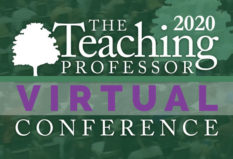
Q&A: A Virtual Chat with a Few of Our Teaching Professor Conference Presenters
The Teaching Professor Conference is an event where educators who are passionate about the art and science of teaching gather every year. This year, the

The Teaching Professor Conference is an event where educators who are passionate about the art and science of teaching gather every year. This year, the

This article is featured in the resource guide, Effective Online Teaching Strategies. The transition to online teaching has been partially, if not completely, challenging for

As the clock seems to race through the final minutes of an exam, several students frantically scan questions and fill in bubbles to demonstrate their

Different generations of students have enrolled and graduated from higher education institutions for many decades. Throughout these decades, educators have been using the same strategies

Students can have a hard time seeing how general education requirements and foundational classes help them achieve their goals. Students, especially adult learners, want to

As a teacher of writing and mindfulness, I often use cross-genre approaches in my classrooms. For my writing classrooms, that might mean simple breath work,

This article is featured in the resource guide, Effective Online Teaching Strategies. When I was asked to create an online course 20 years ago, I

Having taught college for five years now, I sometimes take for granted that teaching methods that seem obvious now were once foreign to me. So,

This article is featured in the resource guide, Effective Online Teaching Strategies. By now, most educators have seen the images of equity versus equality versus

Editor’s note: This article was featured on The Teaching Professor in December 2018. For more articles like this, learn more about a Teaching Professor membership.
Get exclusive access to programs, reports, podcast episodes, articles, and more!